Domestic goose Anser anser x Anser cygnoides x Mute Swan Cygnus olor hybrid
A hybrid between a swan and a goose is commonly known as a swoose. When I saw the bird below I could find few documented records of hybrids between swans and geese, and there seemed to be very few photographs in existence. I have come across at least two or three more since, but they are rare.
(9) L.JPG)
Domestic goose Anser anser x Anser cygnoides x Mute Swan Cygnus olor hybrid, Wool (Dorset, UK), 24th October 2010
In 2004, on the River Frome in Dorset, a Mute Swan paired with a domestic goose and produced a single swoose. This was observed and photographed by members of the Radipole Ringing Group whose research had apparently indicated that such hybrids do not normally survive past fledging. Thus when the bird continued to survive years later, the record was documented, with photographs, in the Radipole Ringing Group report for 2007. This report is privately published and is not available online. Although a few individuals outside of the group were made aware, most UK birders have had little interest in wildfowl hybrids until very recently and news of the bird's existence did not become widely known or publicised until 2010.
The swoose continued to survive, but it wasn't until 2010 that I became aware of its presence, following the publication of new photos on the internet. The first of these were taken by Peter Drury in August 2009 and can be viewed on Peter's website along with further photos taken by Neil Matthews in September 2010 (which are also on Flickr). These photos generated some wider interest and I visited the area in October 2010, still unaware of the bird's history with the Radipole Ringing Group.
During my visit I noticed that the accompanying Mute Swans were ringed and suspected that there would be local birders who were aware of this bird's presence and who might be able to provide some background information, and perhaps confirmation of the bird's identity (the goose parent was not in the photos, or present during my visit, so its identity had been deduced from its appearance alone). An extensive internet search failed to reveal any reference to this bird and the county bird recorder was unaware of its existence. However I submitted details of the accompanying Mute Swans' rings and subsequently these were forwarded to Terry from the Radipole Ringing Group who has kindly supplied me with the background information about the swoose and a copy of the article from their 2007 report. This article describes the bird as a "swarse" - I'm not aware of that term being used elsewhere, except with a very different meaning!
Below are my photos of the swoose, followed by some further discussion about this and previous records of swan x goose hybrids, along with some photos by Dave Callaby of this bird when it was a youngster.
(1) L.JPG)
(2) L.JPG)
(3) L.JPG)
(4) L.JPG)
(5) L.JPG)
(6) L.JPG)
(10) L.JPG)
(11) L.JPG)
(12) L.JPG)
(14) L.JPG)
(15) L.JPG)
(10) L.JPG)
(22) L.JPG)
(25) L.JPG)
(27) L.JPG)
(29) L.JPG)
(30) L.JPG)
(31) L.JPG)
(33) L.JPG)
(34) L.JPG)
(36) L.JPG)
(37) L.JPG)
(41) L.JPG)
(44) L.JPG)
(45) L.JPG)
(48) L.JPG)
(49) L.JPG)
(50) L.JPG)
(51) L.JPG)
(53) L.JPG)
Domestic goose Anser anser x Anser cygnoides x Mute Swan Cygnus olor hybrid, Wool (Dorset, UK), 24th October 2010
Other records of swan x goose hybrids
There are few documented records of other swooses (sweese?) and even fewer photographs. These are all that I could find while I was investigating this record:
- A 1928 paper by John C Phillips published in The Auk concerning a hybrid between a male Black Swan and a female Canada Goose, including black-and-white photos: PDF here.
- An article on the Dutch Aviculture Europe website contains a photo from 2001 of two hybrids between a Mute Swan and a white domestic goose: PDF here (the text is in Dutch).
- An article by Christoph Randler on "Field identification of hybrid wildfowl - Geese" published in Alula in 2001 contained a photo of a hybrid between a Mute Swan and a domestic goose, taken in Switzerland in January 1997. The article describes it as a confirmed hybrid between Mute Swan and Greylag Goose but a photo reported to show its parents shows that the goose parent is a domestic bird and itself a hybrid between Greylag Goose and Swan Goose. A subsequent photo of the same swoose (formerly here but link no longer working), taken 13 years later in 2009, showed that it became lighter over time and the finder, Willi Joss, indeed claims that the male parent was a domestic goose.
- Eric & Barry Gillham's Hybrid Ducks: The 5th Contribution to an Inventory (2002) contains photos of two different swan x goose hybrids. One is a hybrid between a Coscoroba Swan and a domestic goose (Blue Steinbacher, which I think is one of the Greylag Goose x Swan Goose breeds) and the other a hybrid between a Coscoroba Swan and a Hawaiian Goose. In both cases the Coscoroba Swan was the father.
A number of photos or discussions about birds purporting to be swan x goose hybrids actually relate to goose hybrids (typically domestic goose x Canada Goose). Some other references appear to be the result of a misunderstanding that Swan Goose is a species of goose and not a hybrid between a swan and a goose. True swan x goose hybrids appear to be genuinely rare.
An article by Hakon Kampe-Persson and Henrik Lerner (Occurrence of hybrid geese in Sweden – a conservation problem?" Ornis Svecica 17:154-186, published in 2007) refers to a pairing between a Greylag Goose and Mute Swan in Sweden that produced single fledglings in 1972 and 1975. The Greylag father had apparently been raised by a pair of Mute Swans and there are other examples of Greylag Geese being fostered by Mute Swans.
Related and relevant to this, and referred to in the same article, there was a study of 35 Greylag Geese that had been fostered by Canada Geese. Of the 35, 5 males paired to female Canada Geese and if widowed re-paired with Canada Geese again (repeatedly in some cases). The remaining 14 males and all 16 females paired with Greylag Geese. This study was published in 1991 by E Fabricius in Ethology 88: 287–296.
This suggests that a proportion of male geese that are fostered by another species will tend to pair with the foster species. This was evidently the explanation for the Swedish swoose and may well be the explanation for others like the bird in Dorset.
Identification of the Dorset record
We now know that at the time the swoose was first observed as a cygnet (or should that be cysling?) it was being looked after by a Mute Swan and a domestic goose. Domestic geese all descend from either Greylag Goose Anser anser or Swan Goose Anser cygnoides, or both. Domestic variants of Swan Geese are often referred to as Chinese Geese and the article in the Radipole Ringing Group's 2007 report refers to the swoose parent as a Chinese domestic Goose. The accompanying photos include an image of this bird and it does indeed show characteristics of domestic Swan Goose (dark mane and raised knob), however it also appears to show characteristics of domestic Greylag Goose (e.g. orange bill with apparently pale nail).
It is not always safe to assume that a pair of adults accompanying a young swan or goose are actually the biological parents of the young bird. They may have simply adopted the young bird, or another bird may have laid an egg in their nest, the mother may have mated with a bird other than its usual partner, or the mother may have replaced her partner for another since mating. I am not sure how strong the circumstantial evidence was at the time, but in any case it is worth analysing the bird's appearance to see if this supports the presumed identification.
I think it is clear from the structure, especially the neck, that one parent is a swan species - the shape of the neck narrowing this down to Mute Swan or perhaps Black Swan. This cannot be a Swan Goose, other domestic goose, or goose x goose hybrid as has been suggested elsewhere.
Swan x goose hybrids are rare, so we need first to eliminate the possibility of it being a swan x swan hybrid. The obvious choice would be Mute Swan x Black Swan, though the yellowy-orange base to the bill might make us consider Whooper (or Bewick's) Swan x Black Swan too. However, a number of features would be unexpected and difficult to explain for any swan x swan hybrid:
- The primaries are not white where they are on all swan species (including Black Swan)
- The legs and feet are pale
- The yellowy-orange colour on the bill would be unexpected on Mute Swan x Black Swan whereas the combination of raised knob at the bill base and dark plumage would be unexpected on any other swan x swan combination
So we have to look at swan x goose hybrid ("swoose") as the likely identification. The predominantly pinkish-red bill, the mainly black nail and cutting edge, the raised knob, the curved neck and the white head and neck would all be compatible with Mute Swan. It could be argued that the black nail and cutting edge, the knob and the white plumage could all come from the goose parent if that goose was domestic Swan Goose, and that the red bill and curved neck could come from Black Swan instead. There is a sharp demarcation between the pinky red bill and the yellowy-orange base of the bill in the same place as Mute Swan shows demarcation between the red and the black, and this probably lends supports Mute Swan as the likely swan parent. Also the shape of the neck appears to be a more precise match to Mute Swan than Black Swan. So far it looks like Mute Swan x goose sp., with Black Swan x domestic Swan Goose perhaps not being entirely ruled out.
Next to consider the goose parent. We don't have a lot to go on here, but the yellowy-orange tones on the bill base (and also around the nostril) and the orangey legs indicate one of the grey geese of the genus Anser, most likely one with a orangey-coloured bill, such as Greylag Goose. Blue Snow Goose might also be considered, especially in the light of the contrastingly dark primaries, but I am not sure why a hybrid between a red-and-black-billed bird and a pink-billed bird would produce a partly orangey-coloured bill, and if it were Mute Swan x blue Snow Goose I would expect clean white edges to the longer wing feathers. The fact that the nail is not entirely black may indicate that the goose parent was a pale-nailed species, such as Greylag Goose.
A couple of things are worth mentioning as they might lead some observers to question whether Mute Swan x Greylag Goose is a possibility. Firstly the dusky vent might not be expected from a Mute Swan x Anser sp. as both have white vents - however, it is now well established that dusky markings on the vent is a typical and common feature of hybrids between Anser geese and Branta geese where neither parent show such dusky markings, so this may not preclude a swan x Anser hybrid either. Secondly the tone of the dark plumage is rather dark grey, not brown except on the fringes of some feathers, especially on the flanks. Intuitively we might expect a Mute Swan x e.g. Greylag Goose to be much browner than this, however presumed hybrids between grey geese (including Greylag and Pink-footed Geese) and white geese (Snow and Ross's Geese) show similar grey-toned plumage so this might not be preclusive either. Also some Anser x Branta hybrids appear darker than either parent so we should not necessarily expect a Mute Swan x Greylag Goose to show plumage the same colour as, or paler than, Greylag Goose.
My provisional conclusion, prior to me hearing from the Radipole Ringing Group, was that this bird is probably a hybrid between a Mute Swan and a Greylag Goose, but that other Mute Swan x Anser sp. combinations could not be ruled out. Moreover I was not confident that the possibility of it being a Black Swan x domestic Swan Goose, whilst unlikely, was entirely ruled out either.
Although my suspicion was that the bird was probably a Mute Swan x Greylag Goose hybrid, the possibility that the goose parent was a domestic bird with both Greylag Goose and Swan Goose ancestry is also entirely consistent with my analysis.
Thus the bird's appearance is entirely consistent with the presumption that the adult birds looking after it in its first autumn were indeed its biological parents. Whilst we cannot say this is proven without genetic analysis the evidence seems sufficiently strong to leave no reasonable doubt that this bird is a hybrid between a Mute Swan and a domestic goose, the domestic goose itself probably being a hybrid between Greylag Goose and Swan Goose.
Incidentally, feathers were collected from the swoose (from its preening site), and also from its parents, and were sent to a university in order for them to perform some genetic analysis on them. Very unfortunately, the feathers were lost before the analysis could be conducted.
Appearance from 2004 to 2007
Photographs accompanying the article in the Radipole Ringing Group report for 2007 were taken by Dave Callaby on several dates between June 2004 and September 2006. Additional photos by Mike Page show the bird in September 2007. I'm extremely grateful to Dave Callaby for sending me a much larger set of his photos than were published in the ringing report and allowing me to display a selection of them on my website:

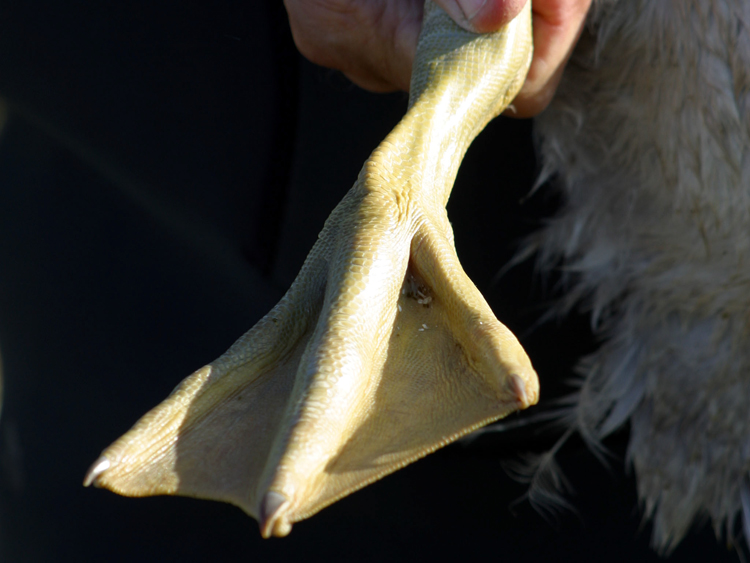


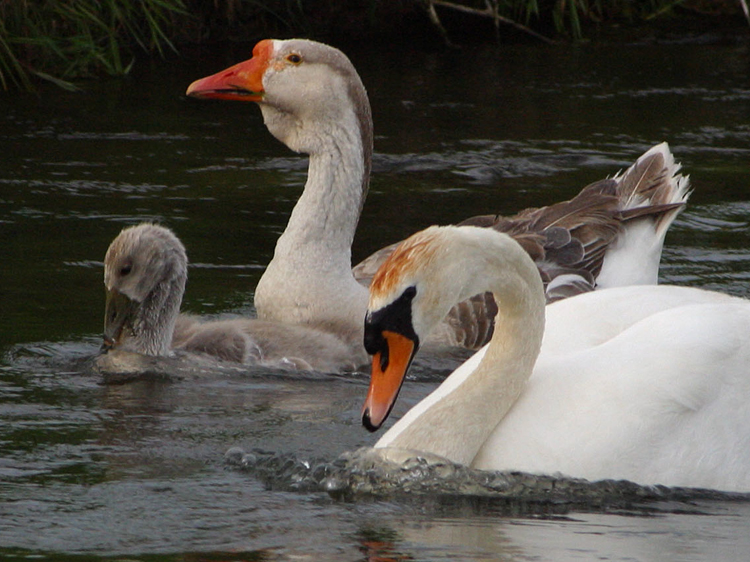
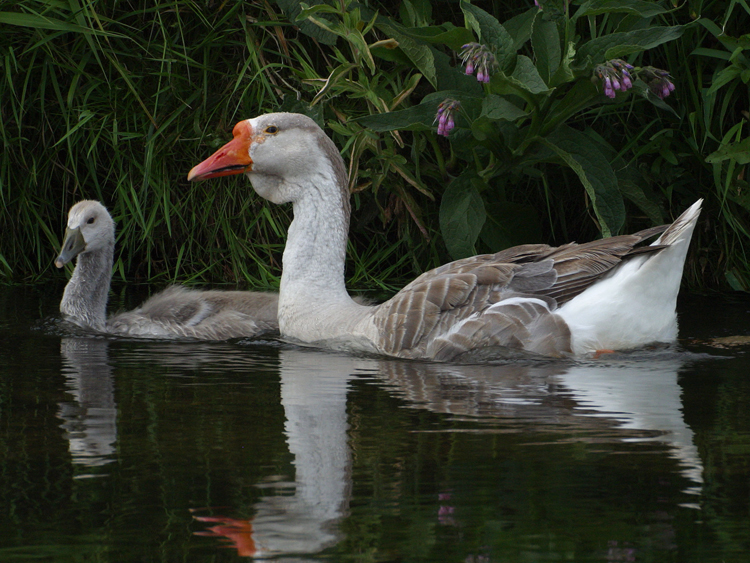
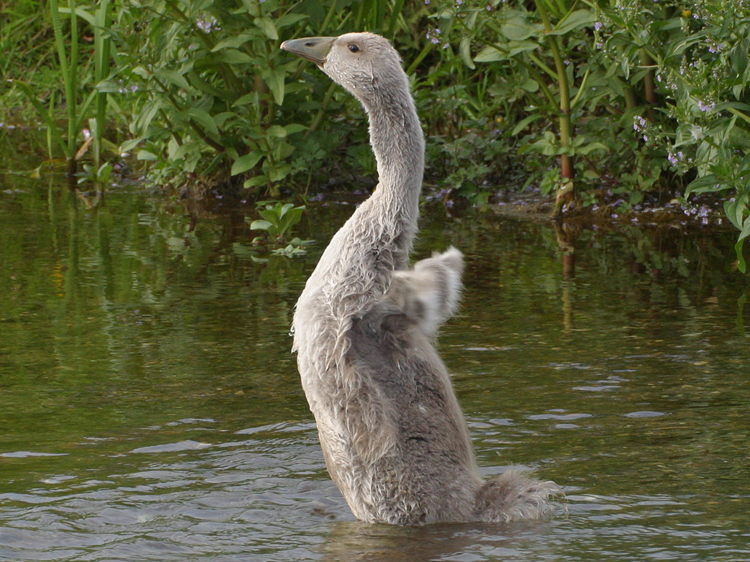
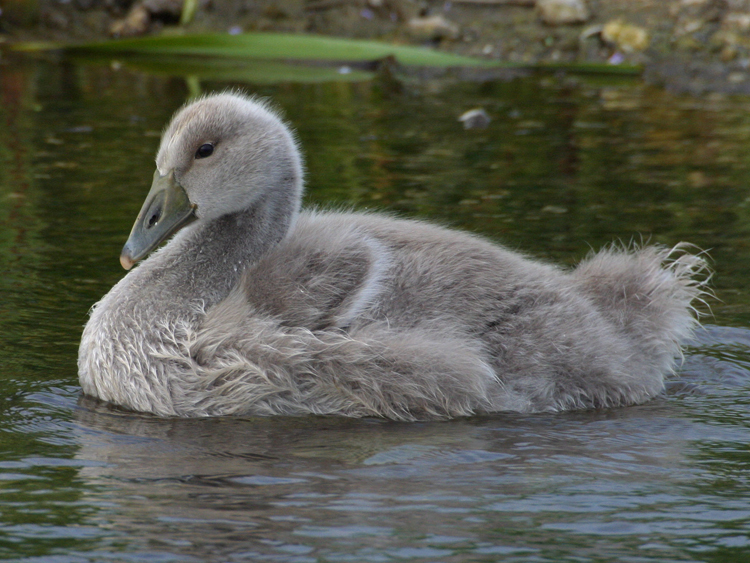

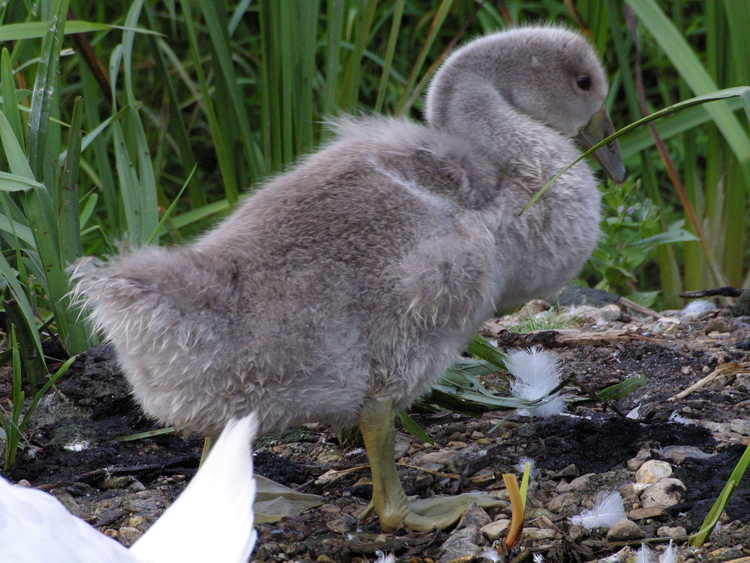
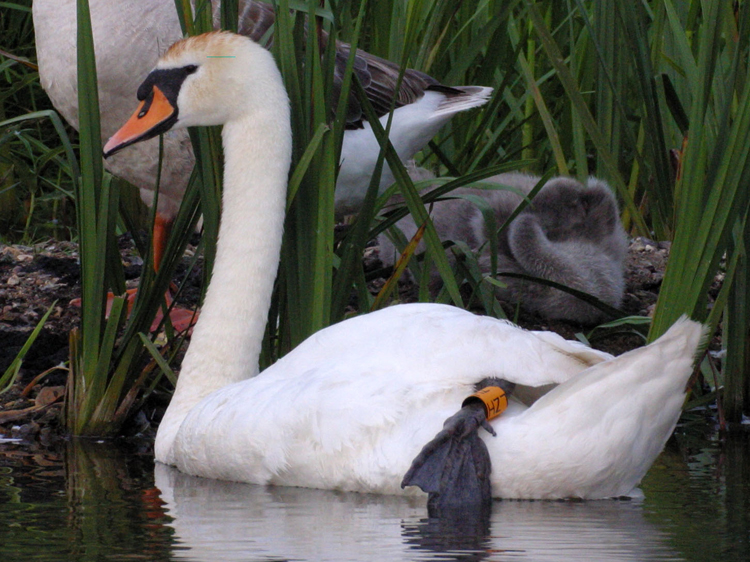
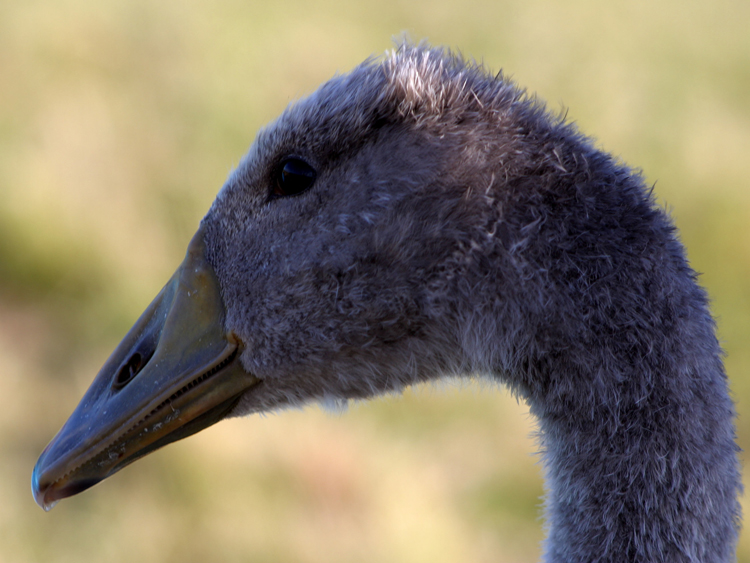
Domestic goose Anser anser x Anser cygnoides x Mute Swan Cygnus olor hybrid with its presumed parent Mute Swan and domestic goose, Wool (Dorset, UK), June 2004 (photos by © Dave Callaby)
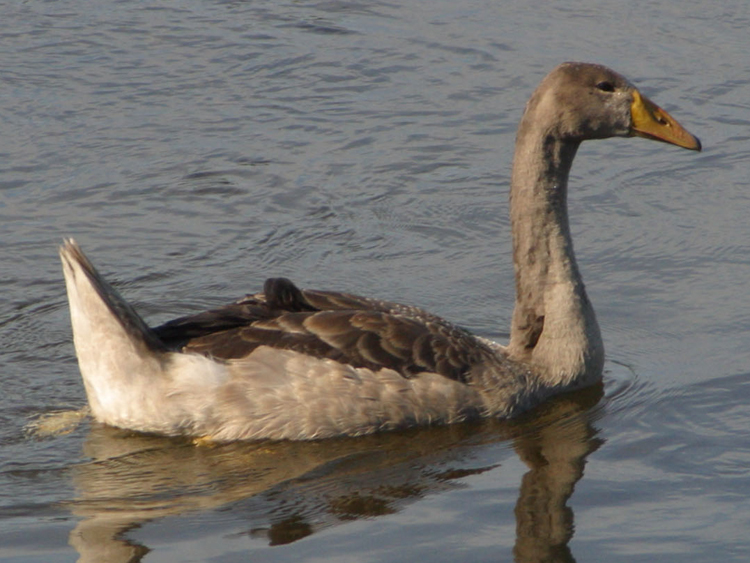
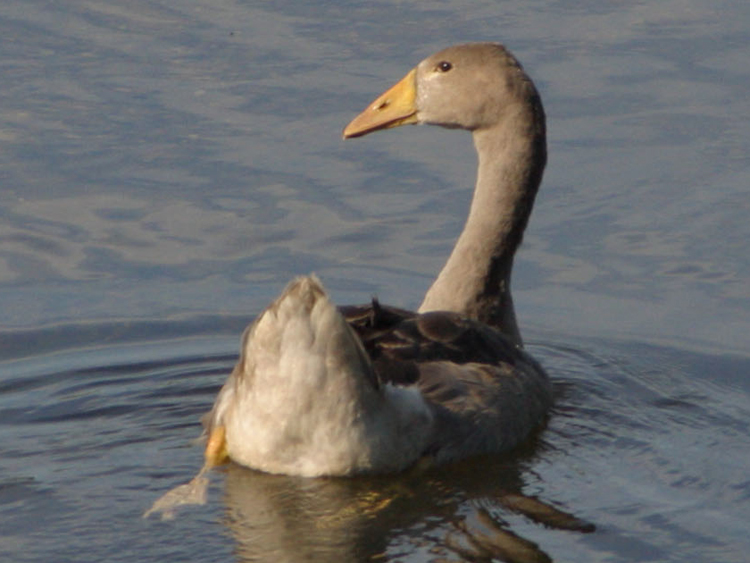
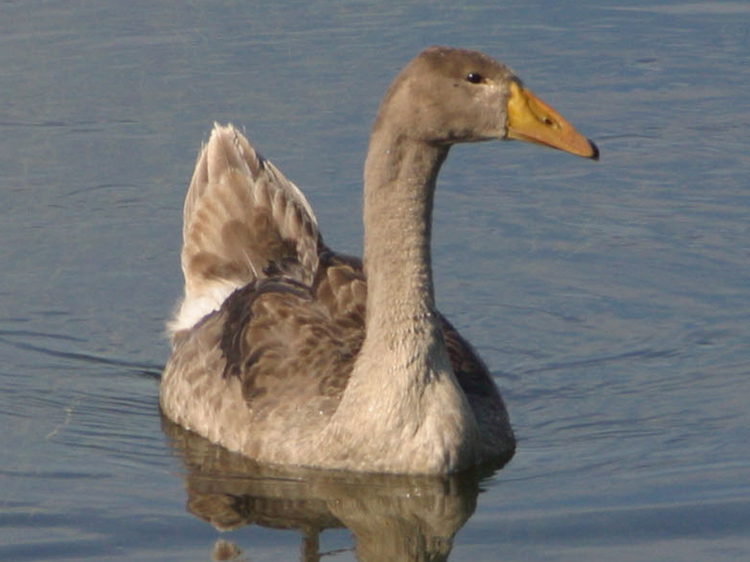
Domestic goose Anser anser x Anser cygnoides x Mute Swan Cygnus olor hybrid, Wool (Dorset, UK), August 2004 (photos by © Dave Callaby)

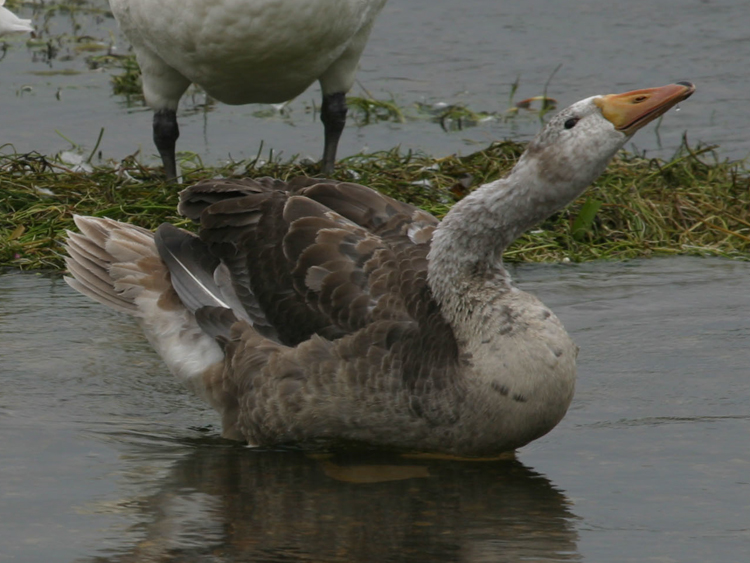
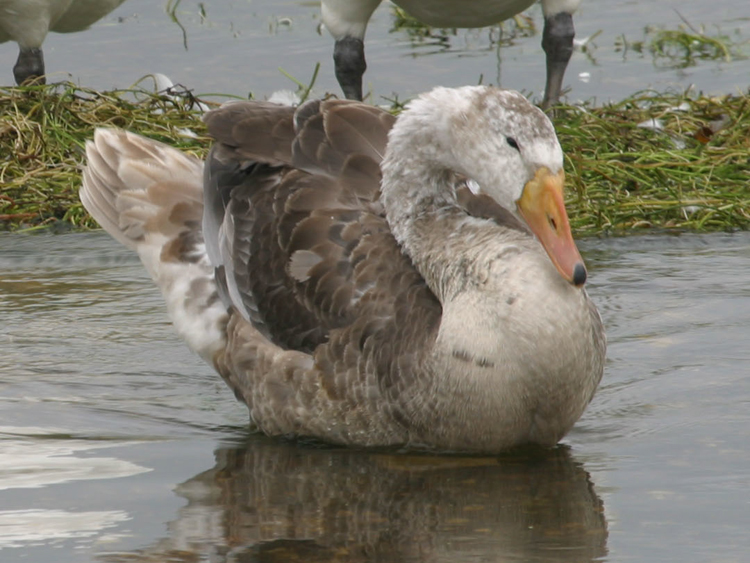
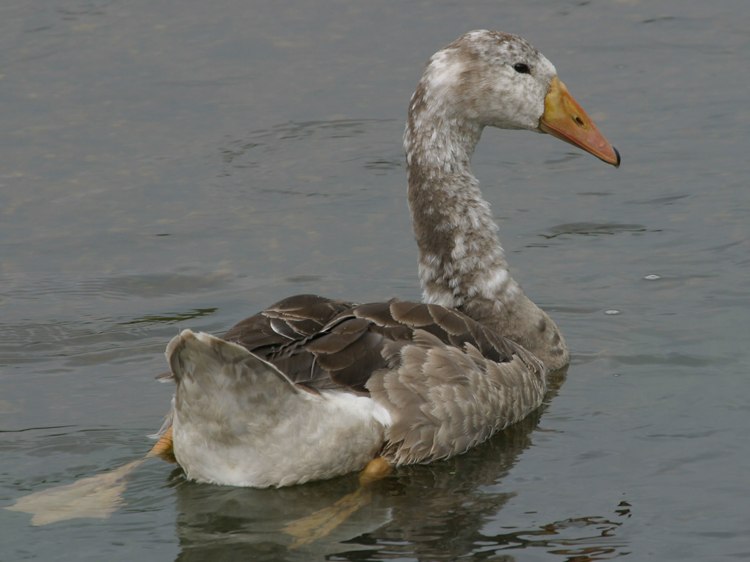
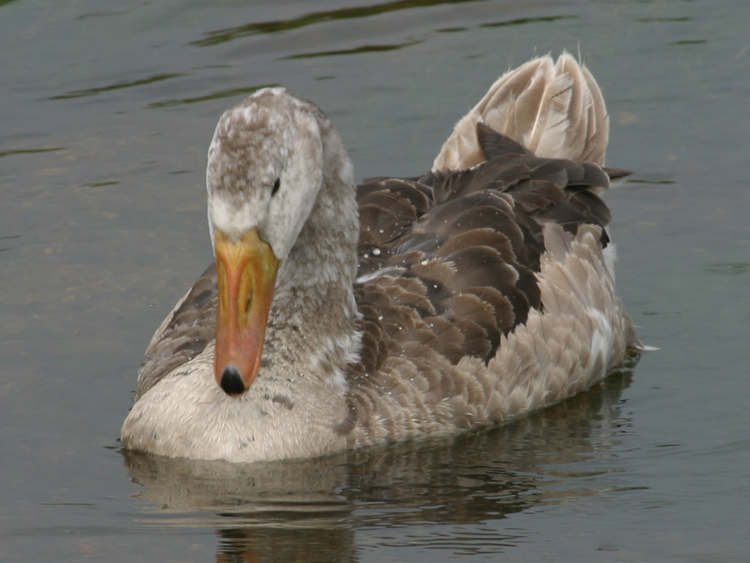
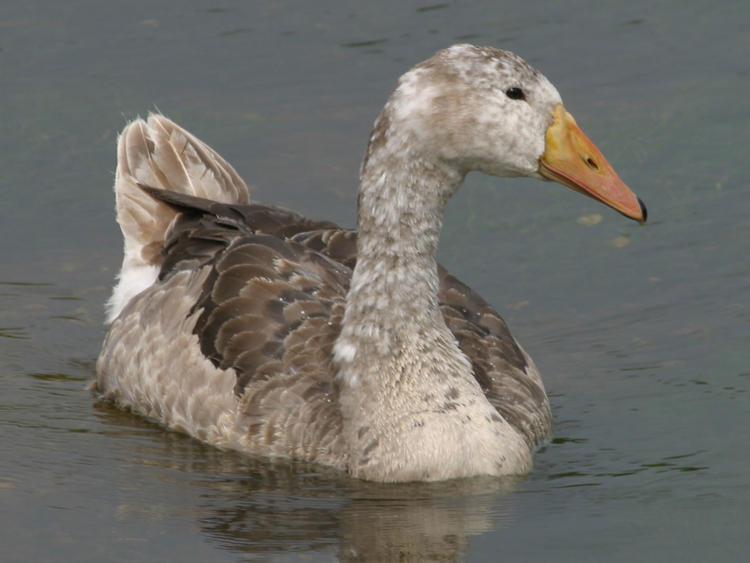
Domestic goose Anser anser x Anser cygnoides x Mute Swan Cygnus olor hybrid, Wool (Dorset, UK), September 2004 (photos by © Dave Callaby)

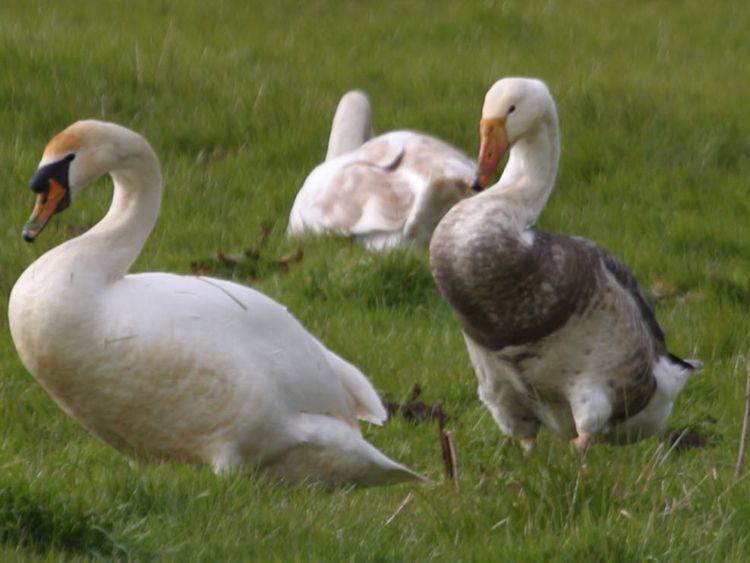

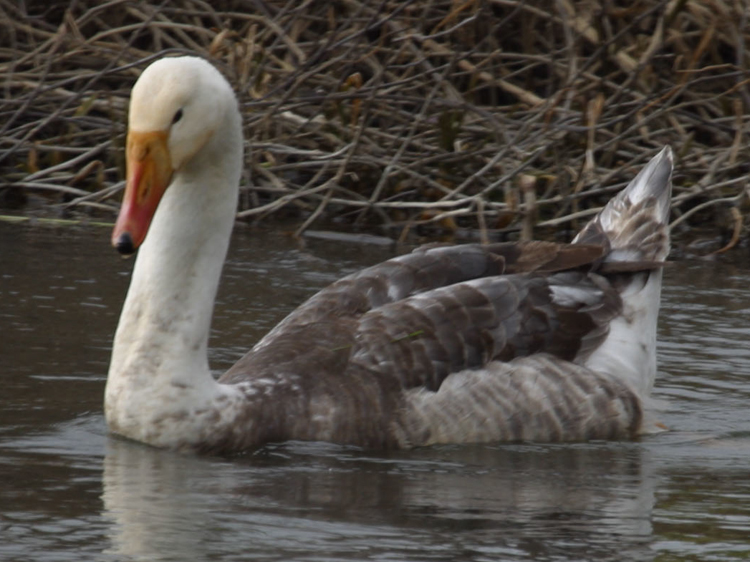
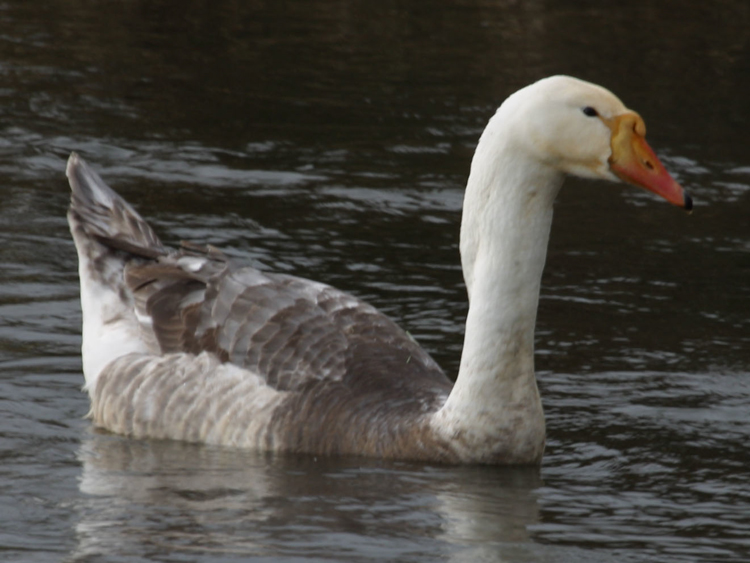
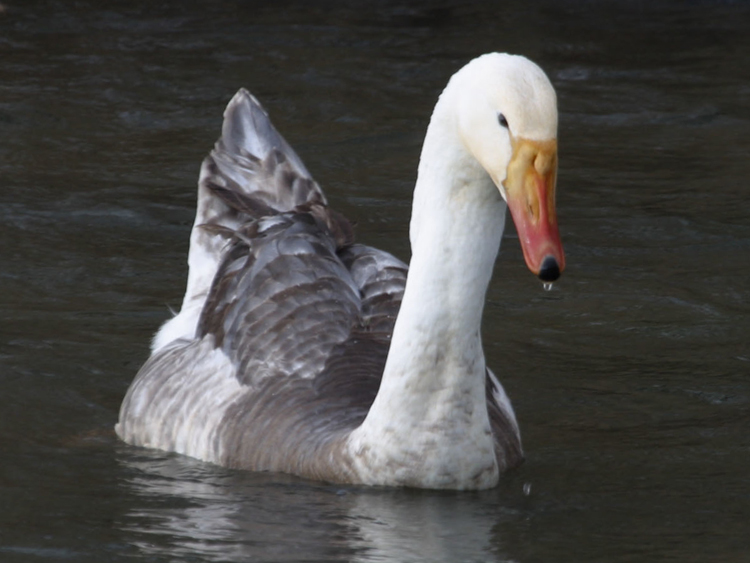
Domestic goose Anser anser x Anser cygnoides x Mute Swan Cygnus olor hybrid (with Mute Swans), Wool (Dorset, UK), March 2005 (photos by © Dave Callaby)
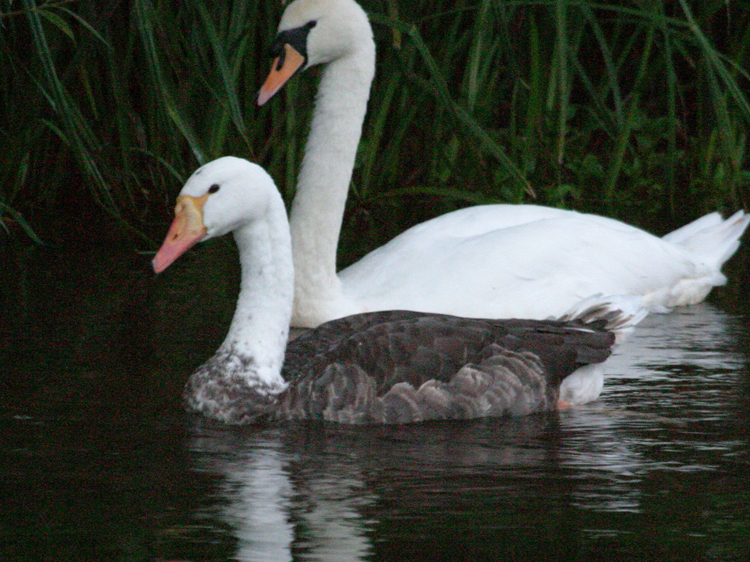
Domestic goose Anser anser x Anser cygnoides x Mute Swan Cygnus olor hybrid (with Mute Swan), Wool (Dorset, UK), September 2006 (photos by © Dave Callaby)
Subsequent sightings
I'm pleased to report that this swoose was still present on the River Frome at the old bridge at Woolbridge on 4th October 2011 - many thanks to David Redwood for this update and for his photos below. The bird's appearance hasn't changed much in the last year, though there are minor differences for instance in the pattern of the dusky markings on the undertail-coverts.
 CIMG7860 L.jpg)
 CIMG7861 L.JPG)
 CIMG7864 L.JPG)
Domestic goose Anser anser x Anser cygnoides x Mute Swan Cygnus olor hybrid, Wool (Dorset, UK), 4th October 2011 (photos by © David Redwood)
Further comments about the accompanying Mute Swans
Of further possible interest are the birds that this hybrid was accompanying. The swoose was in the company of a single adult Mute Swan and two juvenile birds resembling Mute Swans. Given that Mute Swans are reported to pair for life it does not seem entirely unreasonable to speculate that the cygnets might be the offspring of the adult Mute Swan and the hybrid. This would be most interesting were it proved to be true as the chances of any swan x goose hybrid being fertile must surely be very small.
According to Birds of the Western Palaearctic (BWP) long-term monogamy is normal for Mute Swans with males remaining paired outside of the breeding season. However, Terry from the Radipole Ringing Group confirms that whilst they may remain paired they do not necessarily remain side by side throughout the winter (and that fits with my own observations). Thus there is no strong reason to presume that the close association of one adult Mute Swan, one adult swoose and two cygnets should imply that they are a family party.
The adult Mute Swan acommpanying the swoose bore a ring coded KPH, ringed by the Christchurch group but I didn't receive any details. Terry has kindly provided me with ringing details of the cygnets accompanying the swoose (coded AOO and AOP) - they were ringed in the same area on 26th September 2010. A different adult was ringed at the same time (AOK) and was believed to be these birds' father.
Location
This bird was on the River Frome at Wool. It was on the section of river between the A352 and East Burton Road, roughly where the green arrow points in the map below:
View Larger Map
Acknowledgements
Thanks to Joern Lehmhus, Carl-Gunnar Gustavsson and Lars Nielson for drawing my attention to photos of this bird and other swan x goose hybrids and thanks to them also, as well as Henry Lehto, for informed discussion about these and other hybrids.
Thanks too to Peter Drury and Neil Matthews for publishing their photos of this interesting bird.
Finally thanks to Terry Coombs from the Radipole Ringing Group for providing the historic information about this bird and for supplying me with a copy of the article from the ringing report.
Last words...
I don't normally quote the Daily Mail, in fact I despise pretty much everything I've ever heard reported in it, but I enjoyed this quote from 13th July 1920...
A bird prodigy of evil and hybrid character is the despair of a Norfolk farmer. It rejoices in the name of the “swoose”, a portmanteau word indicating its origin, for its father was a swan and its mother a goose. This ill-assorted pair had three children — three “sweese”.
I don't know about Norfolk famers but a century later I know a fair few Norfolk birders who would still regard a bird like this swoose as 'a bird prodigy of evil and hybrid character'!
